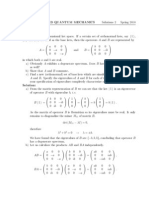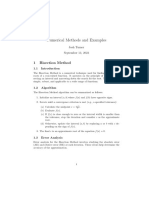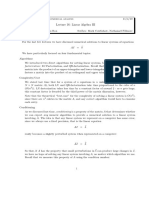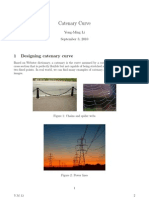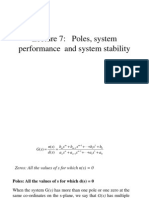Algorithms
Uploaded by
Jouhar SheikhAlgorithms
Uploaded by
Jouhar SheikhME 5107: Numerical methods in Thermal Engineering Jul–Nov 2023
Algorithms
Krithika Narayanaswamy
The following are implied unless stated otherwise.
• A is a n × n matrix
• The system being solved is Ax = b
• L and U refer to Lower triangular and Upper triangular matrices respectively.
• Any index range refer to all numbers in that range. For instance, k + 1 : n refers to the range of numbers
k + 1, k + 2, . . . n. Note that this interpretation also applies to such ranges that appear in the row/column indices
of matrices.
1 Solutions to linear algebraic systems of equations
1.1 Forward Substitution
This solves for y in Ly = b. The diagonals of L matrix take the value 1, i.e., ljj = 1.
y1 = b1 (Assign first unknown trivially)
for j = 1 : n do
sum = 0
for k = 1 : j − 1 do
sum = sum − ljk yk
end
yj = sum
end
1.2 Backward Substitution
This solves for x in U x = y.
xn = yn /unn (Assign last unknown trivially)
for j = n − 1 : 1 do
sum = 0
for k = j + 1 : n do
sum = sum − ujk xk
end
xj = sum/ujj
end
Updated on 2023/08/22 at 12:30:10
ME 5107: Numerical methods in Thermal Engineering Jul–Nov 2023
1.3 Gaussian Elimination without pivoting
This transforms Ax = b into U x = y. Equivalently, this transforms an augmented system (A|b) into (U |y). Note that
row operations are performed on both A and b to get the final simpler system U x = y.
U = A, L = I
for k = 1 : n − 1 do
for j = k + 1 : n do
ljk = ujk /ukk (Multiplication factor)
ujk = 0 (Element underneath pivot)
uj,k+1:n = uj,k+1:n − ljk · uk,k+1:n (Row operations)
bj = bj − ljk bk (Row operations on rhs vector)
end
end
1.4 LU factorization without pivoting
This obtains the factorization A = LU . Row operations are performed on A to obtain the U matrix, and the
multiplication factors used in the row operations are wisely assembled to give the L matrix.
U = A, L = I
for k = 1 : n − 1 do
for j = k + 1 : n do
ljk = ujk /ukk (Multiplication factor)
ujk = 0 (Element underneath pivot)
uj,k+1:n = uj,k+1:n − ljk · uk,k+1:n (Row operations)
end
end
Remarks:
1. Row operations are being performed only on columns k + 1 : n on the j th row. This is because
• the first k − 1 column entries on this row will be zero, and
• the k th entry is 0 upon evaluation. This is assigned explicitly so in the previous step.
2. This approach saves on computational time by avoiding operating and evaluating zero values. This is carried
over for the subsequent algorithms coming up as well.
Updated on 2023/08/22 at 12:30:10
ME 5107: Numerical methods in Thermal Engineering Jul–Nov 2023
1.5 Gaussian Elimination with partial pivoting
This transforms Ax = b into U x = y. Equivalently, this transforms an augmented system (A|b) into (U |y). Note that
row operations as well as row swaps have been done on both A and b to get the final simpler system U x = y.
U =A
for k = 1 : n − 1 do
Select q : |uq,k | = max |up,k |
p≥k
uk,k:n ↔ uq,k:n (Row swap)
for j = k + 1 : n do
mult = ujk /ukk (Multiplication factor)
ujk = 0 (Element underneath pivot)
uj,k+1:n = uj,k+1:n − mult · uk,k+1:n (Row operations)
bj = bj − mult · bk (Row operations on rhs vector)
end
end
1.6 LU factorization with partial pivoting
This algorithm results in the factorization P A = LU . Row operations and row swaps are performed on A to obtain
the U matrix, and the multiplication factors used in the row operations are wisely assembled (after suitable swapping)
to give the L matrix. The permutations are stored in P , which is essentially an Identity matrix with its rows swapped
appropriately. Matrices P , L, and U are needed for subsequently solving the original system Ax = b.
U = A, L = I, P = I
for k = 1 : n − 1 do
Select q : |uq,k | = max |up,k |
p≥k
uk,k:n ↔ uq,k:n (Row swap in U matrix)
lk,1:k−1 ↔ lq,1:k−1 (Row swap in L matrix)
pk,1:n ↔ pq,1:n (Row swap in permutation matrix)
for j = k + 1 : n do
ljk = ujk /ukk (Multiplication factor)
ujk = 0 (Element underneath pivot)
uj,k+1:n = uj,k+1:n − ljk · uk,k+1:n (Row operations)
end
end
Exercise:
1. Using the above algorithm, given matrix A as,
2 1 1
A = 4 3 3
8 7 9
obtain the L, U , and P matrices.
2. Verify that P A = LU .
Updated on 2023/08/22 at 12:30:10
You might also like
- Chió's Trick For Linear Equations With Integer CoefficientsNo ratings yetChió's Trick For Linear Equations With Integer Coefficients3 pages
- Notes On Some Methods For Solving Linear Systems: Dianne P. O'Leary, 1983 and 1999 September 25, 2007No ratings yetNotes On Some Methods For Solving Linear Systems: Dianne P. O'Leary, 1983 and 1999 September 25, 200711 pages
- 1 Solving Systems of Linear Equations: Gaussian Elimination: Lecture 9: October 26, 2021No ratings yet1 Solving Systems of Linear Equations: Gaussian Elimination: Lecture 9: October 26, 20218 pages
- PII - Numerical Analysis II - Iserles (2005) 61pg PDFNo ratings yetPII - Numerical Analysis II - Iserles (2005) 61pg PDF61 pages
- Lu-Decomposition: Gaussian Matrix. Let X Be An N-Vector. We Construct A Square Matrix LKNo ratings yetLu-Decomposition: Gaussian Matrix. Let X Be An N-Vector. We Construct A Square Matrix LK15 pages
- A Quasi-Gauss-Newton Method For Solving Non-Linear Algebraic EquationsNo ratings yetA Quasi-Gauss-Newton Method For Solving Non-Linear Algebraic Equations11 pages
- Carnegie-Mellon University, Department of Electrical Engineering, Pittsburgh, PA 15213, USANo ratings yetCarnegie-Mellon University, Department of Electrical Engineering, Pittsburgh, PA 15213, USA4 pages
- Tutorial On Principal Component Analysis: Javier R. MovellanNo ratings yetTutorial On Principal Component Analysis: Javier R. Movellan9 pages
- The Convergence of Quasi-Gauss-Newton Methods For Nonlinear ProblemsNo ratings yetThe Convergence of Quasi-Gauss-Newton Methods For Nonlinear Problems12 pages
- Linear Algebra Review: Introduction To Machine Learning (CSC 311) Spring 2020No ratings yetLinear Algebra Review: Introduction To Machine Learning (CSC 311) Spring 202028 pages
- Advanced Mathematics For Engineers Part Iv - Pde: Dr. Semu MitikuNo ratings yetAdvanced Mathematics For Engineers Part Iv - Pde: Dr. Semu Mitiku37 pages
- Math 110: Linear Algebra Homework #8: David ZywinaNo ratings yetMath 110: Linear Algebra Homework #8: David Zywina8 pages
- Partial Solutions Manual Parallel and Distributed Computation: Numerical MethodsNo ratings yetPartial Solutions Manual Parallel and Distributed Computation: Numerical Methods95 pages
- Society For Industrial and Applied Mathematics Journal of The Society For Industrial and Applied Mathematics: Series B, Numerical AnalysisNo ratings yetSociety For Industrial and Applied Mathematics Journal of The Society For Industrial and Applied Mathematics: Series B, Numerical Analysis21 pages
- Iterative Methods For Solving Linear SystemsNo ratings yetIterative Methods For Solving Linear Systems32 pages
- CE 007 (Numerical Solutions To CE Problems)No ratings yetCE 007 (Numerical Solutions To CE Problems)19 pages
- Higham, Nicholas J. 2011: Gaussian EliminationNo ratings yetHigham, Nicholas J. 2011: Gaussian Elimination10 pages
- Numerical Method For Regional Pole Assignment of Linear Control SystemsNo ratings yetNumerical Method For Regional Pole Assignment of Linear Control Systems8 pages
- SoftFRAC Matlab Library For RealizationNo ratings yetSoftFRAC Matlab Library For Realization10 pages
- Computer Vision: Spring 2006 15-385,-685No ratings yetComputer Vision: Spring 2006 15-385,-68558 pages
- Lecture 16: Linear Algebra III: cs412: Introduction To Numerical AnalysisNo ratings yetLecture 16: Linear Algebra III: cs412: Introduction To Numerical Analysis7 pages
- Student Solutions Manual to Accompany Economic Dynamics in Discrete Time, secondeditionFrom EverandStudent Solutions Manual to Accompany Economic Dynamics in Discrete Time, secondedition4.5/5 (2)
- Naïve Method. Code:: Naive, Rabin-Karp, and Knuth-Morris-Pratt Algorithms For String MatchingNo ratings yetNaïve Method. Code:: Naive, Rabin-Karp, and Knuth-Morris-Pratt Algorithms For String Matching5 pages
- LO - SCI 3530 Numerical Methods For Partial Differential EquationsNo ratings yetLO - SCI 3530 Numerical Methods For Partial Differential Equations3 pages
- VLSI Architectures For Iterative Decoders in Magnetic Recording ChannelsNo ratings yetVLSI Architectures For Iterative Decoders in Magnetic Recording Channels8 pages
- Optimization Module For Abaqus/CAE Based On Genetic AlgorithmNo ratings yetOptimization Module For Abaqus/CAE Based On Genetic Algorithm1 page
- An Intuitive Approach To DTW - Dynamic Time WarpingNo ratings yetAn Intuitive Approach To DTW - Dynamic Time Warping10 pages
- Hashing Algorithm Linked Hash Map - Notes Lyst8155No ratings yetHashing Algorithm Linked Hash Map - Notes Lyst815510 pages
- Comparative Evaluation of Ann and LMS Based Algorithms For Adaptive Noise CancellationNo ratings yetComparative Evaluation of Ann and LMS Based Algorithms For Adaptive Noise Cancellation9 pages
- Seminars in bio lecture6 2022 GraphنيناااااNo ratings yetSeminars in bio lecture6 2022 Graphنينااااا22 pages
- Control Lecture 8 Poles Performance and Stability100% (1)Control Lecture 8 Poles Performance and Stability20 pages
- Event-Driven Data Acquisition and Digital Signal Processing-A TutorialNo ratings yetEvent-Driven Data Acquisition and Digital Signal Processing-A Tutorial5 pages
- Dokumen - Pub - Nonlinear Optimization 9783030194611 9783030194628No ratings yetDokumen - Pub - Nonlinear Optimization 9783030194611 9783030194628374 pages
- An Introduction To ROC Curve (Receiver Operating Characteristics)No ratings yetAn Introduction To ROC Curve (Receiver Operating Characteristics)16 pages
- Decimal Place Rounding: Name: Class: DateNo ratings yetDecimal Place Rounding: Name: Class: Date4 pages



























